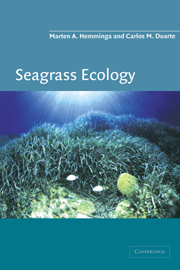2 - Seagrass architectural features
Published online by Cambridge University Press: 29 September 2009
Summary
Introduction
The few members of the angiosperm flora that have succeeded in adapting to submersed life in the sea share a common architecture, all species being clonal, rhizomatous plants. This clonal nature has been interpreted as a necessary adaptation for angiosperm growth in the high-energy marine environment (Sculthorpe, 1967). A consequence of the clonal nature of the seagrasses is that they display a highly ordered growth programme (Tomlinson, 1974), developed through the regular addition of the basic set of modules. Thus, a general understanding of the design of seagrasses will provide insight into their growth patterns (Patriquin, 1973, 1975; Tomlinson, 1974; Sand-Jensen, 1975; Duarte & Sand-Jensen, 1990; Duarte et al., 1994). Although the repertoire of architecture and associated growth programmes that seagrasses display is certainly narrow, they contain sufficient plasticity to yield order-of-magnitude variability in the clonal growth between individual shoots of seagrass species (Marbà & Duarte, 1998), as well as in their reproduction and dispersal. Even within a species, the plasticity of its growth programme and architecture allows the plants to cope with stress and heterogeneity in the environment, as has been extensively documented for land plants. This plasticity is also a central trait in the ecology of seagrasses.
In this chapter we provide a description of the basic architecture of seagrasses, the growth patterns resulting from their design, and their plasticity in growth characteristics to cope with stress and resource heterogeneity.
- Type
- Chapter
- Information
- Seagrass Ecology , pp. 27 - 64Publisher: Cambridge University PressPrint publication year: 2000
- 2
- Cited by



